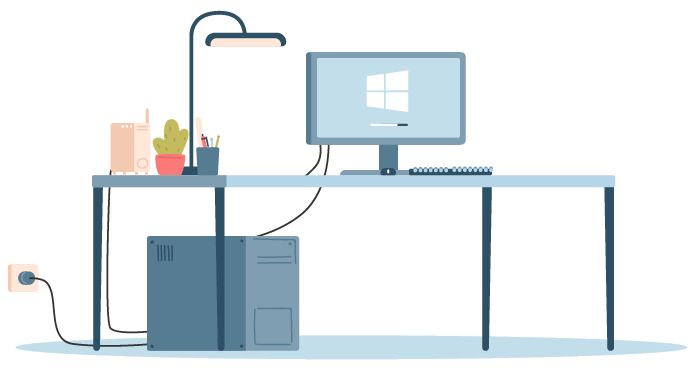The previous chapter explored the different environments in which an IT technician can work and the various people they are likely to interact with. Now we’re going to look at their daily tasks so that you can get insight into your future activities as an IT technician.
Understand the Main Activities of an IT Technician
The role of an IT technician is to ensure that the IT equipment functions correctly and provide solutions to users in the event of defects or problems. This role includes many tasks and responsibilities, which we’ll now explore.
Configure IT Equipment
One of the main activities of an IT technician is to install and configure client machines for users.
A client machine is a computer users use to do their daily work. Workstation refers to the user’s computer.

They also install operating systems on these workstations. Operating systems link the machine's electronic components and the user interface. The user interface is what the user sees and does on the computer. You’ve likely heard of Windows, OS X, and Linux operating systems!
Once the physical hardware is in place, they can then install and configure the business applications: business software, messaging software, folder access appropriate to the department, internet browser, etc.
They also set up various peripherals, such as keyboards, mice, screens, webcams, projectors, and printers.
Provide Access to Services Across a Network
You’ve seen that one of the tasks is to set up client machines (or workstations) for the users.
Well, they also need to set up servers.
Is that a machine that serves coffee? 😋
Almost!
What exactly do you mean by service?
To find out, you first need to understand networks. In an IT system, all of the equipment links together to form an IT network.
At the heart of this network, the server provides information, stores data, or hosts applications that should be available to all connected equipment when required. These are network services.
An IT technician will also set up and configure servers within the organization’s network so users can access their services from their workstations.
Provide Technical Support
A company’s users have a workstation and can access the services they require.
So, our work is done. Can we go on holiday now? 😎 🌴
Not quite yet! Because there's a strong possibility that the users will encounter IT problems as they go about their daily work. The primary responsibilities of an IT technician involve dealing with user requests, providing guidance, troubleshooting if something goes wrong, and suggesting the most appropriate solution.
They will need to provide in-person support for hardware issues or remote support via video conference, telephone, or remote access software.
Advise and Guide Users
Beyond fixing problems, an IT technician also has an advisory role.
They are often responsible for training employees and guiding them on using their workstations, additional equipment, and software.
In addition, they are also involved in data security for the organization, ensuring that users comply with internal resources and data rules.
It’s crucial that everyone, not just IT technicians, knows their responsibilities and the rules when using technology. Some of these rules are in the National Cyber Security Centre’s Advice and Guidance (U.K. government website).
Manage IT Assets
As well as managing and fixing user problems, an IT technician also manages IT assets.
To manage assets, they must log equipment (workstations, servers, network components, printers, desk and mobile phones, keyboards, screens, mice, etc.) into an inventory tool designed for IT asset management.
An IT technician needs to plan to replace faulty equipment and consumables, such as hard disks, keyboards, printer toners, etc.
Replacement equipment in stock and available to use is called a spare.
They're also responsible for preventive maintenance of the IT equipment, keeping the various applications and systems updated, and ensuring that backup processes run smoothly.
A good overview of the IT equipment is necessary to keep it all operating correctly.
Let's Recap!
An IT technician requires the following skills:
Customer support skills to be able to respond to IT user requests.
System and network skills to ensure that services and applications are ready to use once deployed on the internal network.
Maintenance skills to manage the IT equipment and keep it running.
Educational skills to support users in their daily use of the IT resources.
Technical skills are great. But other attributes will make you a well-rounded IT technician. Let’s find out more in the next chapter!
